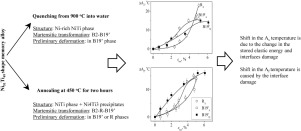Sensors and Actuators A: Physical ( IF 4.1 ) Pub Date : 2020-02-19 , DOI: 10.1016/j.sna.2020.111911 Sergey Belyaev , Natalia Resnina , Timur Rakhimov , Vladimir Andreev

|
The aim of the present work was to study the martensite stabilisation effect in Ni51Ti49 alloy with different structures and martensitic transformations. The quenched Ni51Ti49 alloy underwent the B2→B19’ transformation, whereas the B2→R→B19’ transformation occurred in the annealed sample. The martensite stabilisation effect was studied after deformation in the B19’ state in both samples, and in the R state in the annealed sample. It was found that despite the sample structure, no plastic strain appeared during deformation up to 7%, however, the martensite stabilisation effect was observed in both the quenched and annealed samples. If deformation occurred due to the reorientation of the R phase, the martensite stabilisation effect was negligible and did not exceed 1 °C. If the stress induced B19’ phase appeared during deformation in the R state, the martensite stabilisation effect occurred. It was found that the shift in the reverse transformation temperatures on heating of the pre-deformed sample, depended on the structure of the B19’ phase. It was assumed that the damage to the interface coherency resulted in the appearance of an additional energy barrier that influenced the finish temperature of the reverse transformation. Furthermore, it was believed that the martensite reorientation during deformation changed the stored elastic energy, and the shift in the start temperature of the reverse transformation was due to the change in the stored elastic energy and loss in the interface coherency.
中文翻译:

不同结构和马氏体相变的富NiNiTi形状记忆合金的马氏体稳定作用
本工作的目的是研究具有不同结构和马氏体相变的Ni 51 Ti 49合金中的马氏体稳定作用。Ni 51 Ti 49的淬火合金经历了B2→B19'转变,而B2→R→B19'转变发生在退火样品中。研究了两个样品在B19'状态下变形后以及退火后的样品在R状态下变形后的马氏体稳定作用。发现尽管样品具有结构,但在变形直至7%的过程中都没有出现塑性应变,但是,在淬火和退火样品中均观察到马氏体稳定作用。如果由于R相的重新取向而发生形变,则马氏体稳定作用可忽略不计且不超过1°C。如果在R状态下的变形过程中出现应力诱导的B19'相,则发生马氏体稳定化作用。结果发现,加热预变形样品后,逆相变温度发生了变化,取决于B19'相的结构。假定对界面相干性的损害导致出现了一个额外的能垒,该能垒影响了逆相变的完成温度。此外,据信变形过程中的马氏体重新取向改变了所存储的弹性能,并且逆相变的起始温度的偏移是由于所存储的弹性能的改变和界面相干性的损失引起的。











































 京公网安备 11010802027423号
京公网安备 11010802027423号